Warning (16 page)
Authors: Sophie Cunningham

In answer to complaints about the living conditions in the camps, the Darwin Reconstruction
Commission replied in September 1975: âYou will appreciate that the construction
of permanent works on the site [at One Mile] has to await the deliberations of the
judicial body that is examining the title to this portion of land.'
10
But, as Bill
Day goes on to point out, the system could move fast enough when it came to, say,
letting out contracts for 1600 new houses in the suburbs of Darwin. In response to
this the Gwalwa Daraniki Association began its own appeal for emergency funds. This
did not resolve their problems, however. A donation of forty thousand dollars from
the Papua New Guinea government for a shelter for Aborigines at Knuckeys Lagoon âjoined
other funds for fringe dweller reconstruction and emergency relief which were frozen by a bureaucracy worried about a lack of legal title. In
addition, there were to be no grants of leases for Aboriginal town camps while the
future plans for Darwin were being debated.' The community is now known as Belyuen,
but the housing has not improved. Some thirty years later, the community still lived
in the temporary structures built a few months after the cyclone.
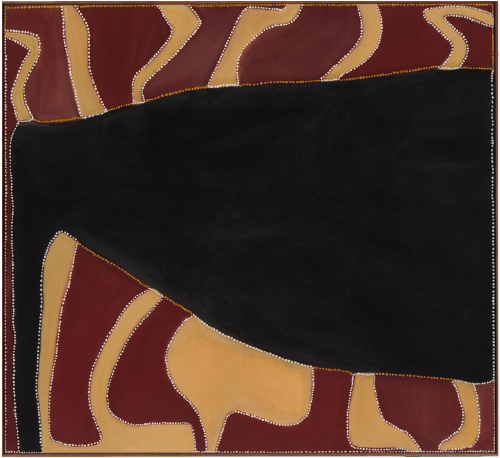
Rover Thomas [Joolama]
Kukatja/Wangkajunga peoples
c.1926 Australia â 1998
Cyclone Tracy
1991
natural earth pigments on canvas
168 Ã 180 cm
National Gallery of Australia, Canberra
Purchased 1991
© THE ARTIST'S ESTATE COURTESY WARMUN ART CENTRE
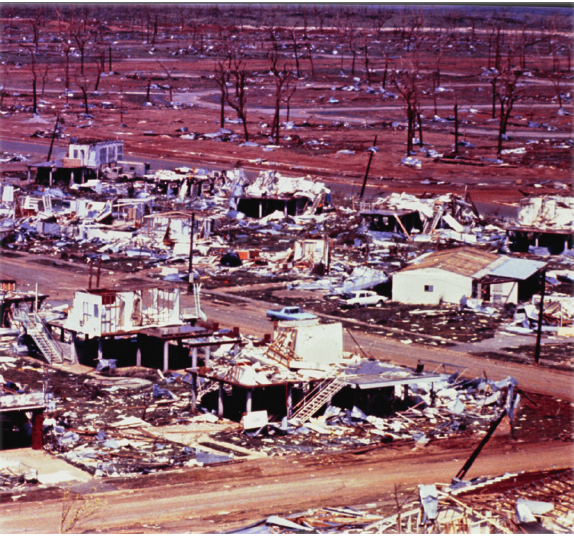
Aerial view of damage
RICK STEVENS / FAIRFAX
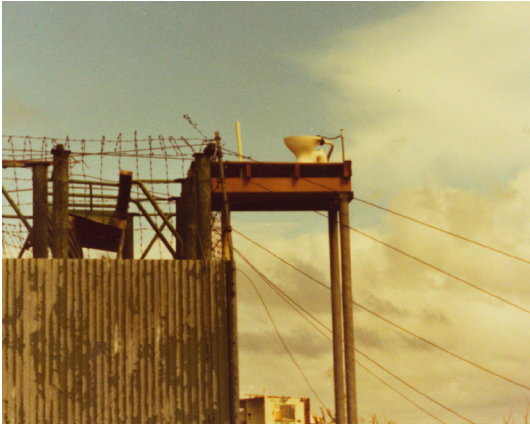
Last can standing
ALBERT A. DIXON COLLECTION, NORTHERN TERRITORY LIBRARY
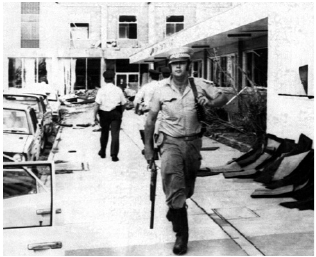
Armed police patrol the streets of Darwin to stop looters
NEWS LTD / NEWSPIX
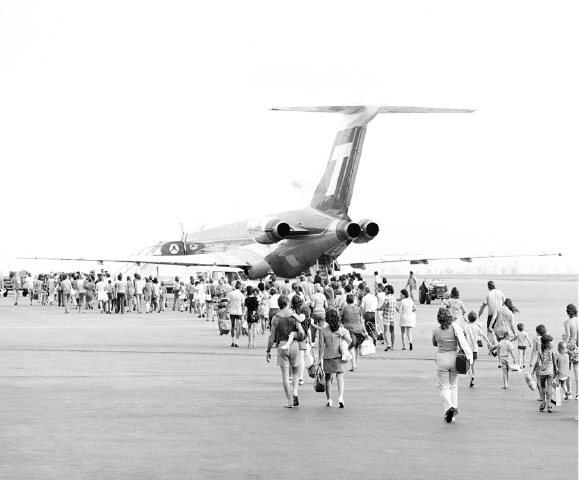
Evacuation via TAA
FROM THE COLLECTION OF THE NATIONAL ARCHIVES OF AUSTRALIA: A6180, 7/1/75/54
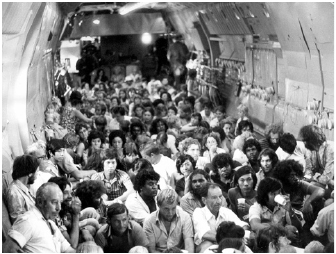
Evacuees aboard a US Air Force Starlifter
NEWS LTD / NEWSPIX
There is some validity to the argument that Indigenous people might be less distressed
by the aftermath of a cycloneâboth because they were less beholden to material things
and because what they did have to lose (land) had been taken from them alreadyâbut
that argument can be taken too far. Indigenous people are no more resilient than
anyone else when it comes to corrugated iron flying through the air. Bill Day: âThe
Aboriginal people in the camps who had experienced the cyclone now had a wariness
of using loose corrugated iron for self-made humpies and of building under trees.'
The situation of Aboriginal people during cyclones remains a vulnerable one. One
Mile camp has been in operation since the early 1900s and was granted a special lease
in 1978. In 2005 the area was described as âDarwin's own little Soweto' by the camp's
project officer, Mick Lambe. It comprises âa crumbling toilet block; and what is
literally a wire-netting walled cage, like a zoo cage, that is the women's refuge
from drunks the police dump at the camp during the night'. There were only about
twenty people there when Tony Clifton visited in 2004 because Aboriginal people are
effectively kept out of town during the dry season so as not to upset the tourists.
âBut there might be 200 or more once the tourists leave in the wet and Aboriginal
money becomes good again.' When I visited the camp during the dry of 2011 there were
even fewer people. This pattern of pushing people out in the dry season and allowing
them back in the wet means they are more likely to be in residence during the cyclone
season. Now, as in 1974, the ruined infrastructure which abounds in these camps can
become deadly if whipped up into the air during a cyclone.
Many remote Indigenous communities in Australia are in areas at most risk of a ânatural'
disaster but the Northern Territoryâin fact Australia in generalâis a long way away
from having developed protocols around the evacuation of Aboriginal people. This
is difficult, it must be acknowledged, because every Indigenous community is different,
and a âone size fits all' approach would not be much use. What is essential is having
emergency services personnel who, if they are not actually from the community, know
and work closely with them. A case in point was the evacuation undertaken before
Cyclone Monica, a Category 5, hit the northern tip of Arnhem Land in 2005. Elders
were invited to play an active role and, importantly, avoidance relationships were
respected. These relationships are particularly important because they dictate who
can be in close proximity to whom. If these aren't understood and worked around,
people might simply refuse to get onto the transport being offered. In this case
the liaison officers were Indigenous, which made a huge difference to the emergency
evacuation work.
11
On the other hand there are many examples of evacuations that have caused extreme
stress. The Western Desert community of Kiwirrkurra, badly flooded in March 2001,
was a dry community but was evacuated to a community where drinking was allowed.
There was such âsevere disruption to the social fabric of the community'
12
that they
decided to move themselves closer to home and just stayed wherever they could. It
was eighteen months before they were able to return to their land.
Evacuation was also distressingly disruptive to the people of the Warmun community
in Turkey Creek, home to the art movement that had been triggered by artistic response
to Cyclone Tracyâparticularly the Gurirr Gurirr paintingsâand Rover Thomas's extraordinary
oeuvre, which includes some of the most iconic visual images of the cyclone. (No
other artists have painted the recent history of northern Australia in such an ambitious,
or, indeed, historically significant fashion. Thomas's painting in the late seventies
inspired those around him, including Queenie McKenzie, a Gija elder and stock-camp
cook who is now as famous as Thomas. âIf he can do that so can I,' she said.
13
And
so an art movement was born.)
In July 2010, it rained sixty-seven millimetres in a single day at Fitzroy Crossing,
and, locals told me, closer to a hundred millimetres in other areas of Central Kimberley.
It typically doesn't rain a drop in July. Six months later the people of Warmun began
to dream that something was amiss. On Sunday 13 March 2011, after days of heavy rainfall
caused by a cyclonic depression, floodwaters began swelling Turkey Creek. In the
space of a few short hours that afternoon, the creek rose beyond measure and a torrent
of water sweeping across the red plains engulfed the remote community, washing away
walls and taking a thousand paintings. Nicolas Rothwell reported in the
Australian
:
âIt was devastation: houses were wrecked, trailers and demountables were smashed
and turned upside down, refrigerators lodged high in the branches of trees.' One
local, Leanne Mosquito, later said that the loss of so many paintings was devastating
because it meant a loss of knowledge: âPeople paint about their country. They talk
about country through painting.' Art centre manager Maggie Fletcher and her husband
Gary were able to save three hundred or so works of the Warmun heritage collection,
but the community had to be evacuated to Kununurra, where tension was experienced
between the people of Warmun and the people whose country it was. There are many
reasons for this but one was that no formal permission was asked of the Indigenous
community in Kununurra. Welcome to Country, like other Indigenous protocols, is not
just a politeness. It's essential if two communities are going to live together.
The point is illustrated by Maggie Fletcher's account of what the three hundred people
evacuated after the flood experienced:
This was a traumatic timeâ¦In a state of shock, lobbed together in a workers' âvillage'
in Kununurra, the community members suddenly found themselves homeless evacuees
in a foreign land. It was two weeks later that one of the most senior artists managed
to ask, âWhere are we?'â¦What this man meant was: âWhose country are we on? This is
not our countryâwe shouldn't be here without their permission.' The people felt they
couldn't paint there. It wasn't right. They didn't like the paint. âThat's gardiya
paintâwhite fellas paint. It's no good. It's not from our country.'
